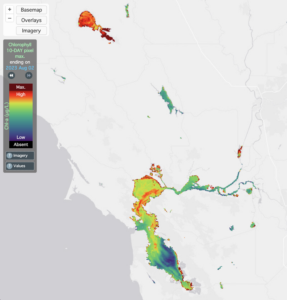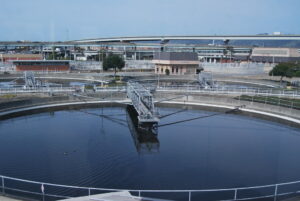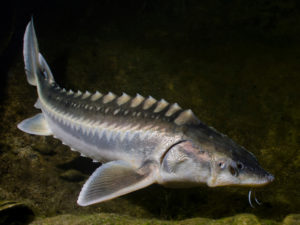For the joggers and dog walkers who frequent the rocky shore between San Francisco’s Fort Mason and Aquatic Park, it was a wholly unexpected sight for a typical morning in the city: a commercial fishing boat just a few yards from shore, its nets crammed with glittering, silvery fish.
“That was a pretty good day, I have to admit,” recalls Ernie Koepf, who made the catch aboard his boat, the Ursula B., in January 2008. “We filled the boat with 14 tons of fish in a couple of hauls. The people on shore were yelling and clapping. I don’t think it’s something they’re going to forget anytime soon.”
Koepf was catching Pacific herring, an eight- to ten-inch-long fish valued more for its eggs (roe) than for its flesh. When herring come into San Francisco Bay from the open sea to spawn in winter, they congregate around “structure”–pilings, rocks, heavy growths of seaweed–to lay their eggs. During robust spawning periods, these areas become positively slippery with herring roe, with egg densities reaching more than 5 million per square meter.
- Ernie Koepf, captain of the Ursula B., is part of the Bay’s dwindling herring fleet. Photo by David Sanger.
This roe smorgasbord inevitably attracts gulls, other seabirds, and commercial fishermen, all seeking gravid (pregnant) female herring. Processed herring roe is considered a delicacy in Japan, and there can be big money for the people who obtain and purvey it. Known as kazunoko, the salted and semidry roe is a key ingredient in traditional Japanese New Year’s dishes.
Koepf’s huge haul was somewhat unexpected. A couple of months earlier, the container ship Cosco Busan had collided with a piling on the Bay Bridge, spilling 58,000 gallons of bunker oil. Fishermen and processors worried that the oil would devastate the herring runs or render the roe unfit for consumption. The long-term effects of the spill remain unclear, but the 2007-2008 herring season was actually a good one. The fish were fairly abundant and, by all evaluations, uncontaminated. Out of an estimated total biomass of 11,183 tons in the Bay, fishermen caught 687 tons, according to the annual survey done by the state Department of Fish and Game.
But Koepf’s vocation is more than an interesting footnote on global trade. It represents the West Coast’s last urban commercial fishery. At one time, San Francisco Bay was heavily fished–for oysters, salmon, sturgeon, halibut, and grass shrimp. Today, the herring fishery is the only remaining commercial operation. It helps keep us connected not just to Bay Area maritime traditions, but also to the fact that the Bay and estuary are a living natural system. Despite its compromised water quality, reduced freshwater flows, and beleaguered wetlands, the Bay is still a thriving wildlife habitat, teeming with a rich array of creatures.
Mostly, this habitat and its wild residents are invisible to us. True, sea lions and harbor seals can be observed when they haul out, and gray whales and the occasional humpback grab headlines when they wander through the Golden Gate.

- Herring boats at dawn, with the San Francisco skyline just emerging from the fog. Like the fishing boats, hungry seagulls and other birds converge on spawning herring. Photo by Stacy Boorn.
But the big aggregations of bait fish, the schools of striped bass, the migrating salmon, the halibut lurking half-buried in the silt, the six-gill and seven-gill sharks in the deepwater channels, the leopard sharks on the flats, all the hundreds of thousands of metric tons of crustaceans and mollusks–they go unnoticed. So when city dwellers look to the water and see a boat filling its holds with herring, the reality comes home: It’s wild out there.
Like anchovies and sardines, Pacific herring are a forage fish, essential midlevel components in the marine food web. They generally feed on plankton and are then in turn devoured by larger predators–including salmon, sea lions, cormorants, human beings. They can live many years, annually returning to estuaries to spawn. In Alaskan waters, some venerable specimens may reach almost 18 inches in length; a more typical size is 12 inches. In California, adults top out at eight to ten inches.
Herring need estuaries and structure to lay their eggs. Unfortunately, bays and estuaries are as popular with people as with herring, and reduced water quality has been the inevitable concomitant. Sewage, industrial waste discharges, and storm runoff can all affect the development and survivability of fertile eggs and young fry.
Too, the necessity of concentrating in circumscribed estuaries during the spawning season makes herring vulnerable to overexploitation. Pacific herring live in the open ocean; spawning fish typically enter estuaries only during winter’s higher tides; in San Francisco and Tomales Bay, there may be 15 or more separate spawning “events” per season. When the spawn is on, their estuarine populations are extravagant–the entire herring population for a large chunk of ocean can be jammed around a few hundred square yards of eelgrass flats or rocky breakwater.
In Europe, particularly in the nations surrounding the Baltic Sea, Atlantic herring–closely related to Pacific herring–have been esteemed for centuries for their flesh. They are consumed fried, smoked, kippered, and pickled, eaten for breakfast, for dinner, or as a snack with beer.

- Brown pelicans feast on herring in Tomales Bay. The pelicans are after the fish, but researchers have found that the herrings’ roe are a major food source for many birds. Photo by Galen Leeds.
But there is no similar appetite for herring in the United States. It’s the eggs that drive the Northern California fishery. Kazunoko can fetch more than $50 a pound in Japan during the New Year’s season. But prices vary widely from year to year, and commercial herring fishermen never really know what they’ll be paid from one season to the next. In 2007, Koepf got $700 to $800 a ton for his fish. That was slightly better than in 2006.
In 1997, prices hit $2,300 a ton. And Koepf still dreamily recalls 1981, when he got $2,000 a ton for his fish–more than $4,500 in today’s currency.
“No doubt about it, that was a good year,” he says. “Today, I’d say prices were fairly stable at the low end.”
While the price of herring has been fluctuating in the mid to low range, all the expenses associated with herring fishing–particularly diesel fuel–have been climbing steadily. The winnowing has been severe, with ever fewer boats on the Bay. In 1997, there were at least 80 boats fishing the Bay; in 2007, there were no more than 20.
“It never was the kind of game where there was a level playing field,” says Koepf. “San Francisco Bay is a big place, and the herring can be a lot of different places–or they may not be here at all. The crew that catches the most fish is the crew with the most experience, the crew that has a skipper who has been fishing a long time, who can sense where the fish might be, and when.”
One way to provide some additional stability for the Bay’s herring fishermen would be to develop a local following for the fish. Herring are not only tasty; they have genuine eco-appeal. They feed low on the food chain, making them less susceptible to overexploitation than larger species. They also absorb fewer toxic substances such as mercury, dioxin, and PCBs than fish that forage farther up the web. Finally, like sardines and anchovies, herring are especially rich in omega-3 oils, the desirable fatty acids that reduce “bad” cholesterol in human beings.
“It’s a beautiful fish, firm, meaty, with rich, oily flesh,” said Mike Wineberg, the proprietor of Osprey Seafoods in San Francisco. “They’re really good grilled.”
Still, he acknowledges, “Herring aren’t exactly flying out the door. I’d say they’re at the bottom of a group of underutilized species characterized by growing consumer interest. Part of the problem may be that the season is so short–a month or so. When they’re here, they’re here in quantity, but the rest of the year you can’t get them. It’s a one-shot deal.”
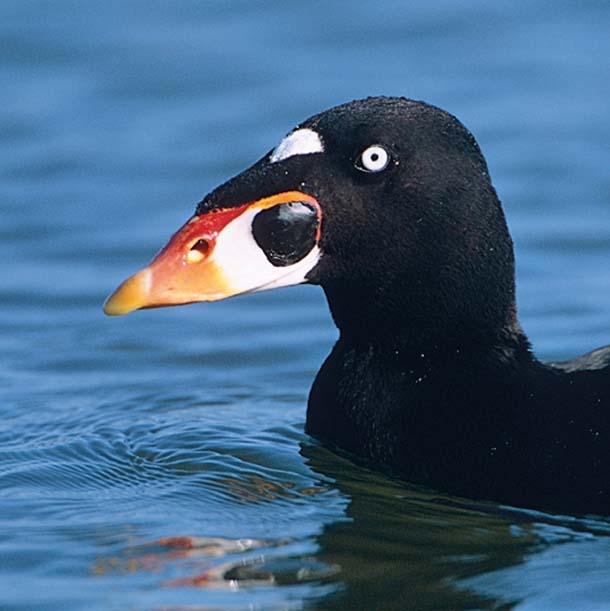
- A study in Tomales Bay found that surf scoters depend heavily on herring roe during the spawn. The San Francisco Bay estuary is home to nearly 80 percent of the surf scoters that winter in the lower Pacific Flyway. Photo by Peter LaTourrette.
There could be a certain inevitability to the future popularity of herring, given the sorry state of other marine fisheries. Salmon fishing was banned off the California coast last year, for the first time since the commercial fishery began more than 150 years ago. Rockfish stocks have plummeted, forcing draconian strictures. White sturgeon are so depleted that only limited recreational fishing for them is allowed, and green sturgeon are federally listed as a threatened species.
Even fisheries that are well regulated and still fairly healthy–Alaskan halibut and salmon come to mind–are insufficient to satisfy the growing demand for wild fresh seafood. So what’s left? The “underutilized” species: sardines, anchovies, and, of course, herring. If we want to keep eating wild marine fish, our options are limited.
For San Francisco Bay’s herring fleet, this grim fact could translate into eventual good news. If Americans start craving fresh herring, the fishermen will be the beneficiaries. Herring prices inevitably would rise. The now-remnant fleet would grow, and we would again see a thriving commercial fishery on the Bay.
But it is by no means clear if a resurgent herring industry would be ecologically sound. By targeting basic forage species, we would be fishing lower and lower on the food chain and chewing away at the foundation of marine productivity.
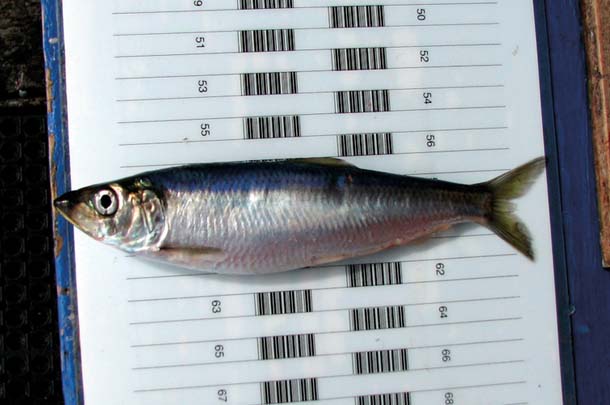
- Pacific herring. Photo by R. Hibpshman.
Locally, Pacific herring are an especially important food source for coastal waterbirds. A 2007 study by Wesley W. Weathers and John P. Kelly, supported by Audubon Canyon Ranch, concluded that the almost 60 species of aquatic birds in Tomales Bay–including surf scoters, buffleheads, and scaups–mainly eat herring roe during the spawning season. The amount of eggs they collectively consume is astounding–perhaps up to 8,000 kilograms (almost 18,000 pounds) a day.
That means that herring–or rather, herring eggs–are more than a convenient food source for opportunistic wildlife, reported Weathers, a professor of animal science at UC Davis: “Our calculations are rough approximations, but they nevertheless indicate that the herring spawn is vitally important, particularly for waterbirds.”
The roe could thus be an essential linchpin in energy transport for many West Coast estuarine ecosystems. Offshore, coastal upwelling brings deepwater nutrients to the surface and plankton populations skyrocket, attracting animals from salmon to blue whales. But it may be the spawning herring that kick a big chunk of that energy farther along the food web.
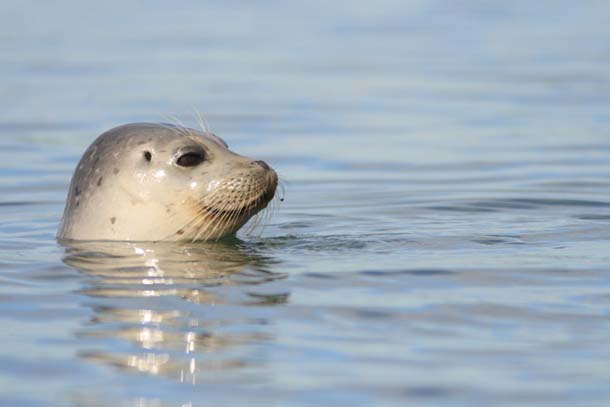
- Harbor seals feed on spawning herring. Photo by Galen Leeds.
Excessive fishing pressure on herring stocks could thus affect more than herring. And we know that forage fish populations can collapse with frightening suddenness. Throughout the early decades of the 20th century, sardines were the basis of a major fishing and processing complex in Monterey. Then in the 1940s, the regional sardine population abruptly crashed, probably due to a combination of overexploitation and oceanic fluctuations. Only in the past 10 to 15 years have sardines recovered moderately.
Herring likely are even more susceptible to excessive fishing than sardines and anchovies because they need bays, estuaries, and rocky coastlines to lay their eggs, and because their spawning aggregations are concentrated and localized; anchovies and sardines, by contrast, are pelagic (open water) spawners.
As a result, the Bay’s herring are among the most studied fish in the region. The tricky task of calculating herring numbers falls to the California Department of Fish and Game, which until the 2003-2004 season used hydro-acoustic devices to estimate the herring biomass. But that approach seemed to result in overestimates, says John Mello, a senior biologist with Fish and Game.
“Commercial fishermen wanted us to continue with that method, but we needed a better way,” Mello says. Biologists now track the herring during the spawning season, surveying egg masses after every major spawning event. Where possible, researchers use weighted rakes to scrape up egg-laden eelgrass and red algae. Egg surveys on rocks and pilings are conducted by visual inspection during low tides.
“We go into known spawning areas and randomly examine the substrate,” Mello explains. “That gives us data on the uniformity of egg deposition. Because we know the available substrate, we can extrapolate the amount of eggs deposited.”

- Herring fishermen working the spawn just off of Sausalito, in Richardson Bay, where spawning herring are often concentrated. Photo by Dennis Anderson.
Mello thinks the current biomass evaluations provide a good assessment of the herring stocks and a sound basis for DFG’s catch limits. But some scientists think our local herring already may be fished too hard.
“I think the fishery is in trouble,” says Bill Sydeman, president and senior scientist of the Farallon Institute, a research group concerned with oceanic and atmospheric changes and their impacts on marine organisms.
Herring can reproduce more than once in a lifetime–unlike Pacific salmon, for example, which die after they spawn. That seems like a reproductive advantage, Sydeman says, but only if older organisms constitute a large percentage of any given population.
“There aren’t many older fish,” Sydeman says. “Older fish tend to be bigger, and they contain more roe during the spawning season, so you get better recruitment. The population trend is down. Sure you get spikes in certain years, but those are anomalies. Overall, over time, the numbers are declining.”
Ryan Watanabe, an associate biologist with DFG, says herring populations are characterized by great variability. From late 2005 to early 2007, a record high biomass was followed directly by record low biomass.
Such dramatic fluctuations probably have more to do with changing ocean conditions than over-fishing, he adds. A few years ago, the virtual cessation of seasonal upwelling abruptly halted the transport of nutrients from deep waters to the surface. This, in turn, scotched plankton production and left little food for herring and other animals on up the food chain.
But Watanabe acknowledges that the general size of the fish caught appears to be declining. “When you see decreasing size in a given age class, that can indicate stress, including overfishing,” he says. “And once fish get smaller, they tend to stay smaller.”
And smaller fish, as Sydeman observes, can mean less roe deposition during the spawn–and ultimately, a smaller herring biomass.
The problem isn’t restricted just to San Francisco Bay. British Columbian biologists also are noting declining fish size in their herring populations.
“It’s an extremely complex situation,” says Watanabe, citing local upwelling variation, hemispheric trends like El Nino and La Nina, fishing pressure–and a simple lack of data, despite DFG’s intensive monitoring. “Our records for Pacific herring only go back 35 years. That’s nothing in terms of time scale, so we really don’t have a sense of what the ‘natural’ fluctuations in the cycles may be.”
Ultimately Pacific herring–if not herring fishermen–may get a break from the international marketplace. Despite efforts to develop ancillary markets for herring, kazunoko still drives the trade. And the demand–and price–for the golden roe seems mired in long-term decline. These days, says Watanabe, younger Japanese are more likely to give a nice bottle of wine as a gift than a box of high-grade kazunoko.
Finally, there is the bottom line. As Koepf observed, fishing costs are spiking; it takes a lot of diesel to operate a herring boat. It’s increasingly difficult to justify the expense.
“Over the past couple of seasons, fishermen have been averaging between $500 to $700 a ton for their fish,” Watanabe explains. “That’s pretty much an historic low. And fuel keeps going up. At a certain point, it’s not going to pencil out.”
But cessation of fishing won’t necessarily mean a permanent herring rebound. The fate of the fishery lies more with oceanic conditions than commercial quotas, Mello says. “At this point, we think we have pretty conservative quotas. The harvest should be sustainable.”
And as far as ocean productivity goes, things have been looking up over the past year. After a severe two-year decline, upwelling during the past 12 months has been vigorous, transporting vast quantities of cold, nutrient-rich water to nearshore areas. Plankton blooms have been extravagant, and krill–the small pelagic crustaceans that are the cornerstone of the North Pacific food web–are extremely abundant.
Even the price of kazunoko may be improving–modestly. “There’re rumors that the price could firm up a bit,” Mello said. “San Francisco Bay has a reputation in Japan for high-quality herring roe–apparently, the processors are signaling some willingness to pay more for our roe this season.”
If economics and ocean conditions remain favorable, our last urban fishery may hang on, reminding those joggers along the Embarcadero that it is indeed wild out there, still.

.jpg)


